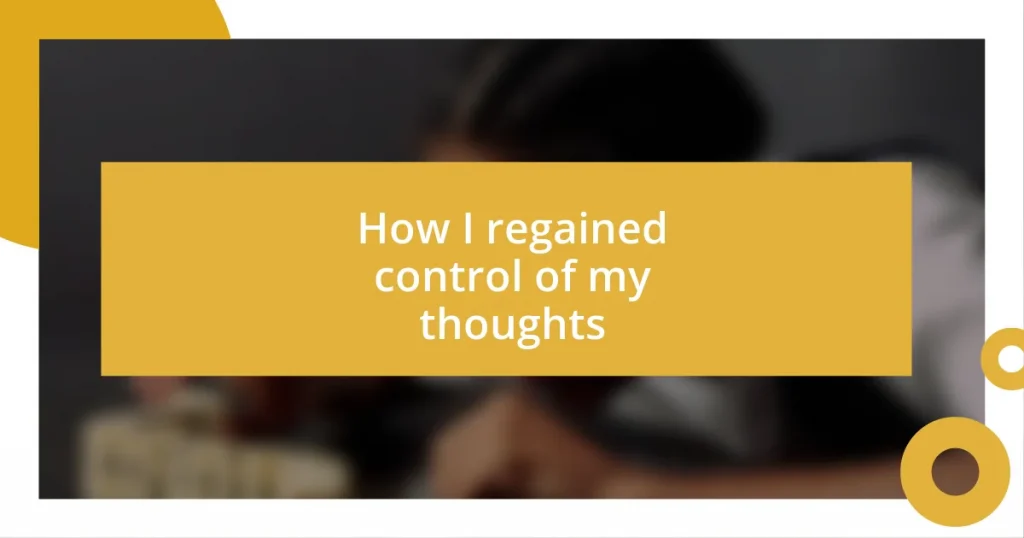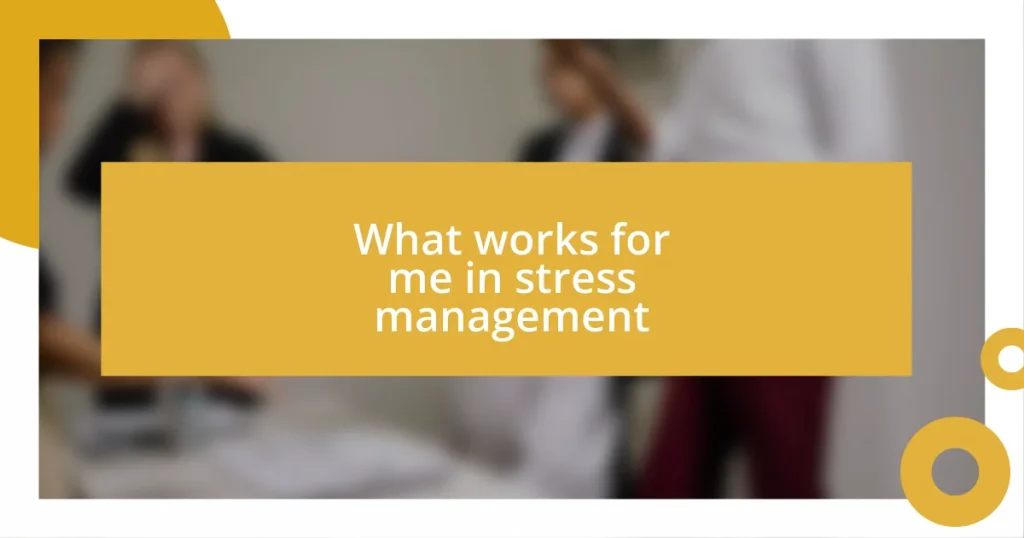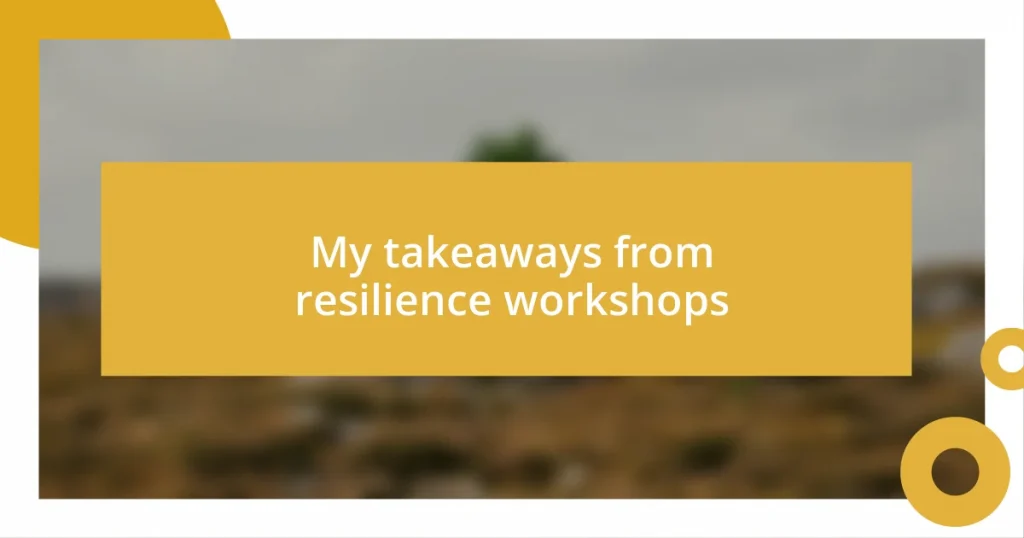Key takeaways:
- Mindfulness techniques, such as breath focus and body scans, help create clarity and manage overwhelming thoughts.
- Cognitive restructuring empowers individuals to challenge negative beliefs and replace them with balanced perspectives, enhancing self-confidence.
- Building a supportive environment, both socially and physically, significantly contributes to maintaining mental resilience and promotes personal growth.

Understanding thought control techniques
When I first started exploring thought control techniques, I often found myself overwhelmed by the flood of thoughts that clouded my mind. One simple yet powerful approach I discovered was mindfulness. By just taking a few moments to focus on my breath, I could create a pause in my racing thoughts and gain clarity. Have you ever tried just sitting in silence and noticing what’s going on inside your head?
Another technique that changed my perspective was cognitive restructuring. I remember vividly a moment when a negative thought spiraled out of control, leading me down a path of worry. But then I learned to challenge that thought by questioning its validity. I would ask myself, “Is this thought really true, or am I just amplifying my fears?” It’s a remarkably empowering shift that can transform how you view your internal dialogue.
Journaling also played a crucial role in my journey. Putting my thoughts on paper helped me to detach from them. I’d often write down my concerns and fears, only to realize how irrational they seemed once they were out in the open. It made me wonder—what thoughts are we holding onto that might lose their power when we bring them to light? This process of externalizing my thoughts has provided me with profound insights and created a pathway to regain control.
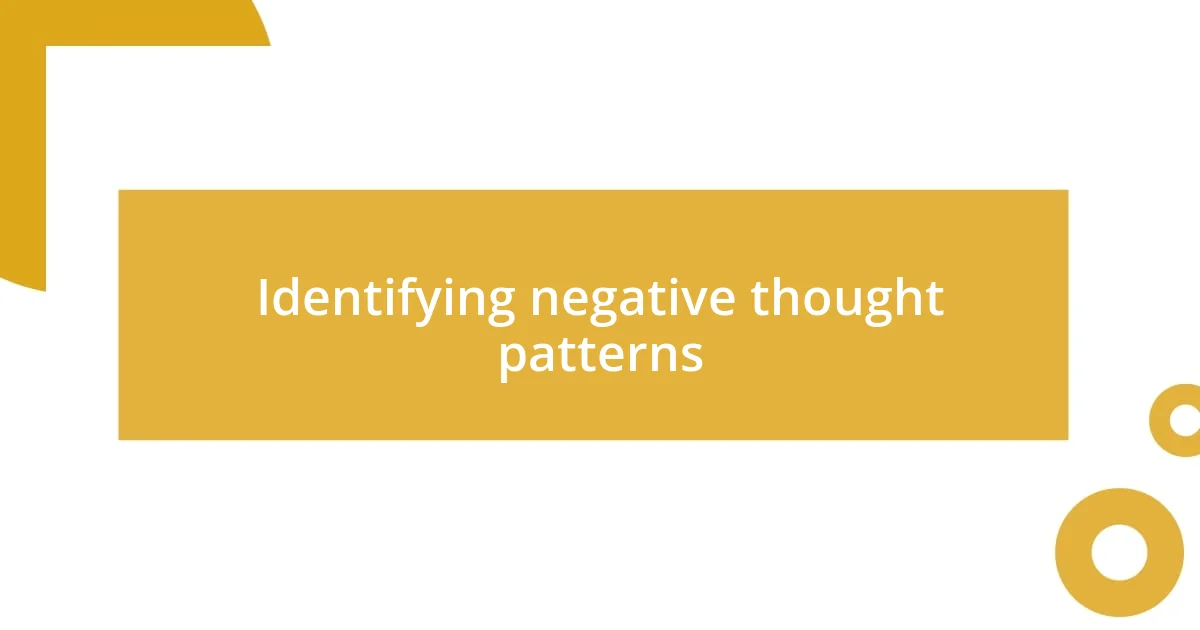
Identifying negative thought patterns
Identifying negative thought patterns can feel daunting, but it’s a crucial step in regaining control of your mind. I remember a time when I couldn’t shake the feeling that I was never good enough. Each time I faced a challenge, that nagging thought would sneak in, tainting my confidence. Recognizing this pattern allowed me to take a step back and reflect on how frequently these beliefs surfaced in my daily life.
To help you identify your own negative thought patterns, consider the following pointers:
- Pay attention to triggers: Notice what situations or events typically spark negative thoughts.
- Record your thoughts: Journaling can reveal recurring themes or beliefs.
- Examine the language you use: Are your thoughts filled with absolutes like “always” or “never”? These can signal an unhealthy pattern.
- Challenge emotional responses: When you feel a strong emotion, ask yourself what thoughts preceded it.
- Look for cognitive distortions: Common distortions include catastrophizing, overgeneralizing, and personalization—these often amplify negativity.
This reflective practice can be transformative, leading to a deeper understanding of your mental landscape, and allowing you to challenge those harmful narratives.
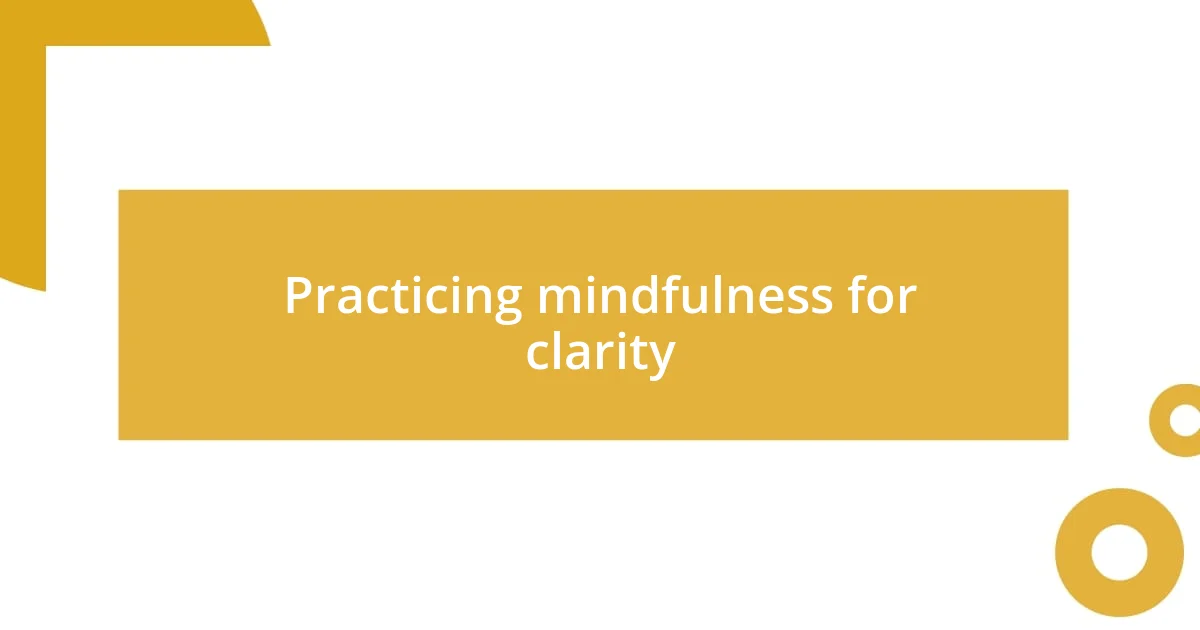
Practicing mindfulness for clarity
Practicing mindfulness has been a game changer for me, especially when it comes to finding clarity amid chaos. One technique I often use is focusing on my breath. I remember a particularly stressful day when I felt overwhelmed by everything on my plate. By simply inhaling deeply and exhaling slowly, I felt the noise in my head begin to quiet down. It’s like hitting a reset button on my thoughts, allowing me to see things more clearly.
Incorporating mindfulness into my daily routine wasn’t just about seeking peace; it became a way to unravel complex emotions. I once struggled with making a significant decision, but during a moment of mindfulness, I allowed my thoughts to flow without judgment. This practice helped me notice the underlying fears that were driving my indecision. Being present illuminated my thoughts in a different light, helping me uncover motivations I wasn’t aware of before.
The beauty of mindfulness lies in its ability to ground you in the moment, creating space for clarity. On one particularly busy day, I found myself caught in a whirlwind of worries. Pausing to practice mindfulness enabled me to separate my worries from my current reality. I realized the power of being conscious of my thoughts and emotions, letting them come and go like waves in the ocean without clinging to them. This experience reminded me that clarity often emerges from stillness.
| Mindfulness Techniques | Benefits |
|---|---|
| Breath Focus | Quiets the mind and fosters clarity |
| Body Scan | Enhances awareness of physical sensations |
| Guided Meditation | Promotes relaxation and emotional processing |

Implementing cognitive restructuring strategies
Implementing cognitive restructuring strategies has been a pivotal part of my journey towards mental clarity. I vividly recall a moment when I felt entirely consumed by a negative belief—I convinced myself that I would fail at everything I attempted. By consciously replacing that thought with a more balanced perspective—like acknowledging my past successes—I began to shift my mindset. Have you ever noticed how changing just one word in a thought can completely alter your emotional state? That’s the essence of cognitive restructuring.
One effective strategy I found helpful was to ask myself, “What evidence do I have to support this negative thought?” This simple question often uncovered the absurdity behind my fears. For instance, when I worried about making a fool of myself in a meeting, I remembered how many times I had contributed successfully in the past. When I reframed my thinking to acknowledge my competence, anxiety began to dissipate. It’s amazing how a little self-inquiry can start to dismantle those walls of doubt.
Additionally, I often turned to visualization techniques. Imagine this: when I faced a daunting project, I would picture myself doing the task confidently and successfully. This mental image became my anchor, helping me believe in my capabilities. Have you ever tried picturing a positive outcome instead of fixating on the negatives? I found that visualizing success not only motivated me to take action but also fortified my resilience against setbacks. By engaging in these cognitive restructuring strategies, I slowly transformed my internal dialogue, making it a much more supportive space.

Creating a daily thought journal
Creating a daily thought journal has been invaluable in my journey to regain control of my thoughts. I remember the first time I sat down with a blank page, feeling a mix of apprehension and curiosity. What would I even write about? To my surprise, once I started jotting down my thoughts, they flowed easily—like releasing a dam of bottled-up feelings. I realized that writing helped clarify my mind, capturing fleeting thoughts and emotions I might otherwise forget.
One approach I adopted was to create prompts for myself. Each morning, I’d ask questions like, “What am I grateful for today?” or “What worries are overshadowing my goals?” This practice opened my eyes to recurring themes in my life. I found that acknowledging these worries on paper made them less daunting; they transformed from abstract fears into manageable thoughts. Have you ever noticed how examining a problem closely can sometimes diminish its power? That was my experience—I felt lighter as heavy thoughts became tangible.
As I reflected on my entries over time, a profound realization dawned on me: patterns emerged that revealed my triggers and emotional responses. There was a day when I noticed how certain interactions drained my energy, prompting me to change my approach in future situations. The act of writing wasn’t just about documenting feelings; it became a tool for self-discovery and growth. I encourage you to give it a try—what might you learn about yourself through this daily ritual?

Building a supportive environment
Building a supportive environment has been essential in my quest for mental clarity. I recall when I decided to surround myself with people who uplifted me, rather than those who fueled my insecurities. There was an incredible shift; I felt their positive energy wrapping around me like a warm blanket. Have you ever noticed how the company you keep can either elevate or drain your spirit? For me, that realization was a game changer.
One day, I consciously sought out friends who inspired me to chase my goals. It was wildly refreshing to engage in conversations that buoyed my confidence, where phrases like “You can do this!” became a common refrain. I would leave those interactions feeling lighter and more motivated. The right environment crafted from supportive influences fostered a sense of accountability, making me think, “If they believe in me, maybe I should believe in myself too.” It’s fascinating how just a few encouraging words can light a fire under your ambitions.
Creating physical spaces that promote positivity was another step I took. I remember rearranging my home office to include items that sparked joy—like photos of cherished moments and motivational quotes that resonated with me. Every time I sat down to work, I felt enveloped by these reminders of my potential. It made me wonder: how does your environment reflect your inner world? For me, a supportive space didn’t just enhance my productivity; it reinforced the belief that I was on a path to growth.

Maintaining long-term mental resilience
Maintaining long-term mental resilience has become a central focus for me over the years. One strategy I’ve embraced is the practice of mindfulness. I remember my first attempt at meditation; it felt awkward sitting in silence, with thoughts racing through my mind like a freight train. But as I persisted, I discovered a surprising tranquility. Have you ever noticed how pausing to breathe can shift your perspective? It’s as if time stretches, giving you space to reflect instead of react.
In addition to mindfulness, I found that nurturing my physical health significantly contributed to my mental strength. On days when I committed to exercise, I noticed an undeniable uplift in my mood; those endorphins worked wonders. There were times when I almost dreaded working out, but once I pushed through that initial resistance, I walked away feeling accomplished. That sense of achievement bolstered my resilience. Isn’t it fascinating how our physical state can profoundly affect our mental clarity and focus?
Furthermore, I’ve learned that building a flexible mindset is key to long-term resilience. Life throws unexpected challenges our way, and I’ve faced my share of them—like when a sudden job loss took me by surprise. Instead of spiraling into despair, I decided to view it as an opportunity for growth and exploration. Shifting my perspective helped me adapt and ultimately led to new paths I never considered before. When was the last time you reframed a challenge as an opportunity? Embracing flexibility in the face of adversity can turn obstacles into stepping stones.










